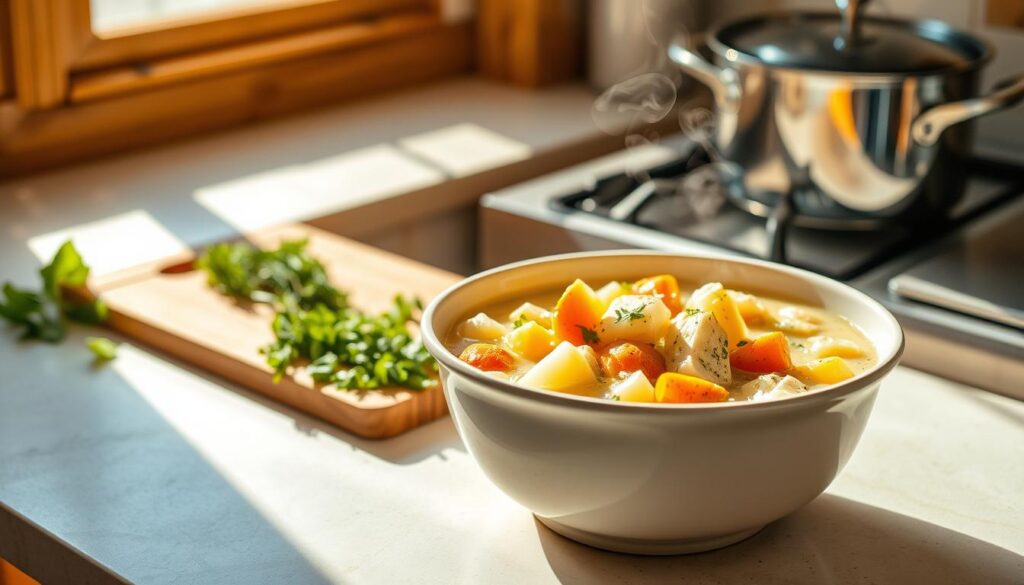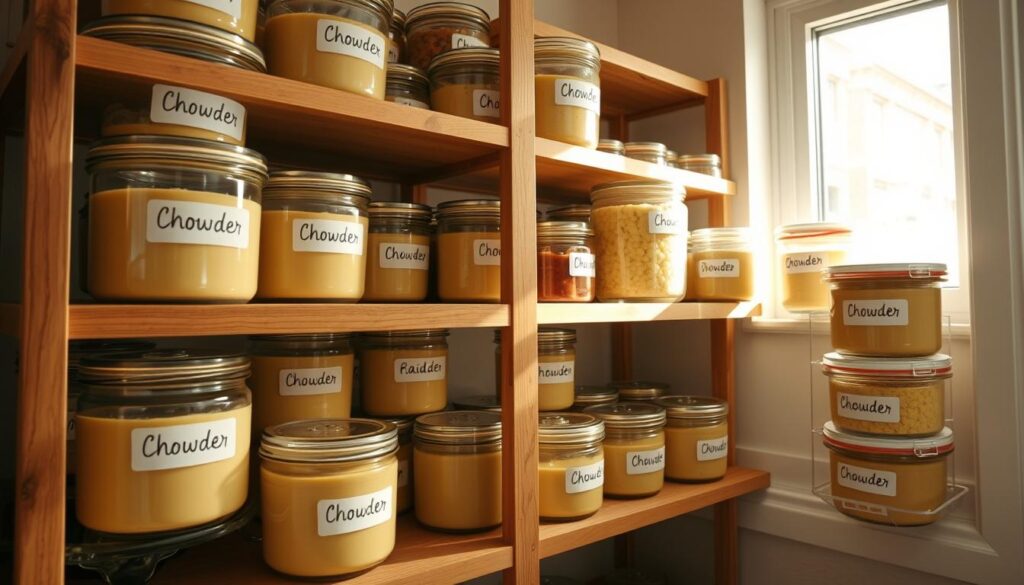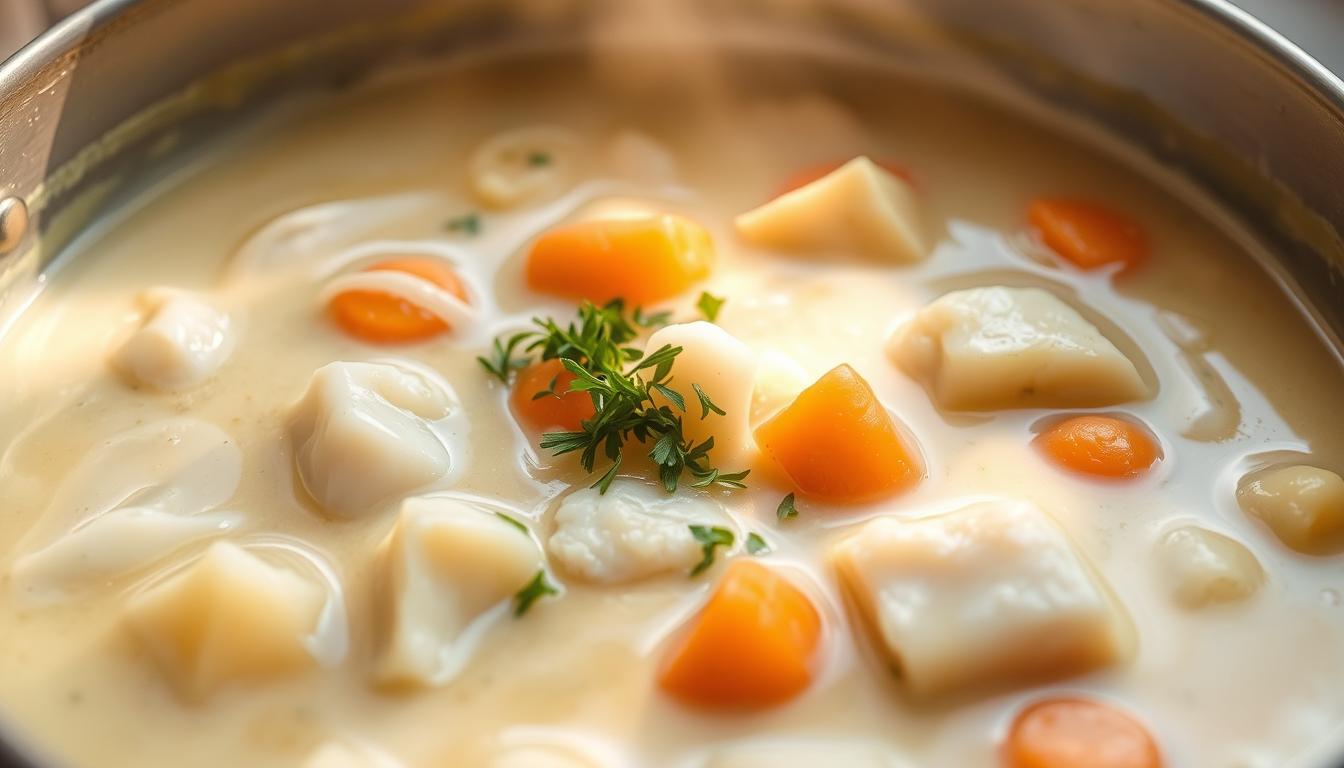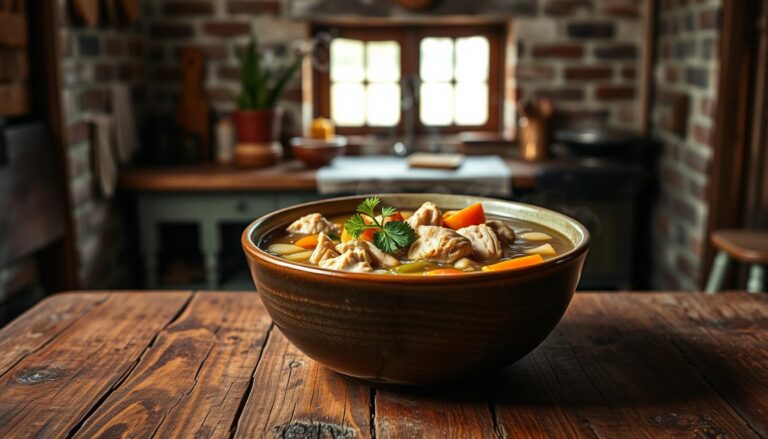Easy Acid Reflux Fish Chowder: A Gentle Recipe
Table of Contents
Living with acid reflux can make mealtime tough. The burning and digestive stress can ruin a warm, comforting chowder. But, what if you could enjoy a delicious, Heartburn-Friendly Recipe that soothes instead of triggers?
This Acid Reflux Fish Chowder is a gentle, nourishing meal for your digestive system. Traditional chowders with heavy cream and spicy ingredients can cause painful reflux. Our version offers comfort without the consequences.
This recipe is made for those with acid reflux. It uses lean white fish, alkaline vegetables, and soothing herbs. Each spoonful brings flavor without the burn, showing you can enjoy food without pain.
It’s quick to make, ready in just 40 minutes, and only 200 calories per serving. This Heartburn-Friendly Recipe is your way back to enjoying warm, satisfying meals. Let’s explore a chowder that cares for your digestive system as much as your taste buds. For more similar recipes, check out Our Flavors.
Understanding Acid Reflux and Its Dietary Implications
Acid reflux is a common digestive issue that can affect your daily life and eating habits. It happens when stomach acid flows back into the esophagus, causing uncomfortable symptoms. Knowing how this condition works is key to finding the right GERD diet meal ideas and recipes for esophageal health.
Your body’s digestive system needs a balance, and acid reflux disrupts it. The lower esophageal sphincter (LES) is like a one-way valve. It keeps stomach acid from going up. But when it fails, you feel the burning and discomfort of acid reflux.
What is Acid Reflux?
Acid reflux happens when stomach contents move back into the esophagus. It affects about 20% of adults in the U.S., with 7% having more severe GERD. Symptoms can be mild heartburn or more serious digestive problems.
Common Triggers to Avoid
- High-fat and fried foods
- Spicy dishes
- Caffeinated beverages
- Citrus fruits
- Tomato-based products
- Carbonated drinks
The Importance of Gentle Foods
Choosing the right foods is crucial for managing acid reflux. Eating smaller portions four to six times a day can help. Stopping when you feel 75% full can also help reduce pressure on the esophageal sphincter and lessen reflux episodes.
Mindful eating is your first line of defense against acid reflux symptoms.
Keeping a food diary can help you find out what triggers your acid reflux. This way, you can create personalized esophageal health recipes that suit your body. By making smart food choices, you can manage acid reflux and boost your digestive health.
Benefits of Fish for Acid Reflux
Choosing the right proteins is key for those with acid reflux. Fish is a top pick for making a Low-Acid Seafood Chowder. It’s good for your digestive health and packed with nutrients.
Omega-3 Fatty Acids and Health
White fish has omega-3 fatty acids, which fight inflammation. These fats are vital for your body’s health. Studies show they can help lessen acid reflux by improving digestion.
- Reduces inflammation in the digestive tract
- Supports cardiovascular health
- Provides essential nutrients without triggering reflux
Lean Protein Sources
Alkaline-Forming Fish Dishes are great for protein without upsetting acid reflux. Lean fish is especially good for those looking for easy-to-digest meals.
| Fish Type | Protein Content | Reflux Friendliness |
|---|---|---|
| Cod | 20g per 100g | Excellent |
| Halibut | 22g per 100g | Very Good |
| Tilapia | 18g per 100g | Good |
How Fish Supports a Balanced Diet
Eating fish can help manage acid reflux and give you important nutrients. A 2017 study of almost 4,000 adults showed that individuals consuming more fruits and vegetables had a 33% lower risk of developing GERD. Fish is a lean, nutrient-rich protein that fits well with this diet.
Fish: Nature’s gentle protein for digestive harmony
Key Ingredients for Acid Reflux Fish Chowder
Creating stomach-friendly seafood meals is all about choosing the right ingredients. Your acid reflux fish chowder needs ingredients that are easy on your stomach and taste great.
When making anti-reflux cooking tips, pick ingredients that are easy on your stomach. They should help with healing and taste good.
Choosing the Right Fish
Choose mild, low-fat fish for acid reflux management:
- Cod: Lean and gentle on the stomach
- Haddock: Low-fat protein source
- Tilapia: Mild flavor with minimal digestive impact
Safe Vegetables to Include
The veggies you pick for your chowder are key for digestive comfort. Go for low-acid veggies that are nutritious and won’t trigger reflux:
- Celery: Provides crunch and subtle flavor
- Carrots: Adds sweetness and nutrients
- Zucchini: Soft texture with minimal acidity
Acid-Alkaline Balance in Ingredients
It’s important to balance your ingredients for stomach-friendly meals. Almond milk is a great non-dairy cream alternative. It reduces reflux triggers while keeping your chowder creamy and tasty.
By picking ingredients that support your digestive health, you can make a delicious chowder. It will nourish you without causing discomfort.
Preparing Your Acid Reflux Fish Chowder
Making gut-soothing soup recipes needs careful steps, especially for those with GERD. This fish chowder is a gentle comfort food that won’t upset your stomach.

Step-by-Step Cooking Instructions
Start your GERD diet meal by gathering these soft ingredients:
- Fresh white fish (such as cod or halibut)
- Low-fat almond milk
- Soft vegetables like zucchini and potatoes
- Fresh herbs: thyme and dill
Cooking Technique for Gentle Digestion
Follow these steps to make your soup:
- Gently sauté diced vegetables in minimal olive oil
- Add low-sodium vegetable broth
- Simmer potatoes until softened
- Carefully add white fish chunks
- Stir in almond milk for creamy texture
Tips for Enhancing Flavor Without Spice
Make your chowder taste great without upsetting your stomach. Use fresh herbs like thyme and dill. They add flavor without causing stomach issues. About 20% of people have GERD, so these gentle cooking tips are key for easy meals.
Pro tip: Keep cooking temperatures low and avoid browning vegetables to prevent creating compounds that might irritate sensitive stomachs.
Creamy Alternatives for Chowder
Making a heartburn-friendly chowder means choosing the right ingredients. Cream-based soups can cause acid reflux. But, with some smart tips, you can make a tasty, gentle recipe that won’t upset your stomach.
Dairy alternatives are key in making Heartburn-Friendly Recipes creamy without discomfort. Let’s look at some options to make your chowder safe and satisfying.
Low-Fat Dairy Options
If you can handle some dairy, low-fat alternatives are a lighter way to creamy soups:
- Skim milk: It has less fat but still creamy
- Low-fat Greek yogurt: Adds protein and thickness
- 1% or 2% milk: Smoother than skim milk
Plant-Based Cream Substitutes
Plant-based options are great for those who don’t want dairy:
- Unsweetened almond milk: Light and neutral-tasting
- Coconut milk: Rich and creamy
- Oat milk: Naturally thick and smooth
- Cashew cream: Luxurious texture
When picking a cream substitute, think about flavor and thickness. Try different ones to find the best for your Anti-Reflux Cooking Tips and taste.
Seasonings and Herbs to Use
Making a tasty Esophageal Health Recipes needs the right herbs and seasonings. These should not trigger acid reflux. The right mix can make your fish chowder taste great and keep your stomach happy.
When making gut-soothing soup recipes, some herbs are better than others. They have mild flavors and help with digestion. Your chowder can come to life with these seasonings:
- Fresh dill – adds a light, crisp flavor without causing irritation
- Parsley – provides a mild, fresh taste and supports digestive health
- Thyme – offers subtle earthiness without increasing acidity
Gentle Seasonings for Flavorful Chowder
Salt is important for flavor, but use it sparingly. For Esophageal Health Recipes, aim for minimal salt. Look for other ways to add taste. Consider using small amounts of:
- Dried herb blends without spicy ingredients
- Mild white pepper (in very small quantities)
- Nutritional yeast for a subtle savory note
Dairy-Free Herb Combinations
If you’re looking for dairy-free options, herb mixes can make your chowder delicious. Try combining:
- Chives with parsley
- Basil and oregano (sparingly)
- Sage with thyme
Remember, the goal is to create a delicious chowder that supports your digestive health without causing discomfort.
Serving Suggestions for Your Chowder
Creating the perfect GERD Diet Meal Ideas means thinking about more than just the recipe. How you serve and enjoy it matters a lot. Your Stomach-Friendly Seafood Meals can shine with the right sides and serving tips.
Perfectly Portioned Accompaniments
When you serve your acid reflux-friendly fish chowder, keep portion sizes in check. This helps avoid upsetting your stomach. Here are some good pairing ideas:
- Low-acid, whole-grain bread (1-2 small slices)
- Light side salad with non-acidic vegetables
- Mild herbal tea or cucumber-infused water
Ideal Serving Sizes for Comfort
For acid reflux sufferers, controlling how much you eat is key. Aim for about 1 to 1.5 cups of chowder. This size is filling without upsetting your stomach.
Temperature and Eating Techniques
Warm your chowder, not scalding hot. Hot food can make acid reflux worse. Let it cool a bit before eating, and eat slowly for better digestion.
Pro tip: Use smaller bowls to naturally control portion sizes and prevent overeating.
Storing Leftovers Safely
Storing your heartburn-friendly recipes right is key for food safety and keeping flavors fresh. Your fish chowder needs special care to keep its nutrients and avoid digestive problems.

Here are the must-follow tips for storing your acid reflux-friendly chowder safely and fresh:
- Cool the chowder quickly to prevent bacterial growth
- Use airtight containers for refrigeration
- Store within two hours of cooking
- Maintain refrigerator temperature at 40°F or below
Proper Cooling Techniques
Quick cooling stops bacteria from growing. Divide your chowder into smaller, shallow containers to cool it down faster. Don’t let the chowder sit at room temperature for too long.
Guidelines for Reheating and Storage
| Storage Method | Maximum Storage Time | Reheating Recommendation |
|---|---|---|
| Refrigerator | 3-4 days | Reheat to 165°F, stirring occasionally |
| Freezer | 2-3 months | Thaw in refrigerator before reheating |
To enjoy your heartburn-friendly recipes best, eat refrigerated chowder within three to four days. When reheating, use gentle heat to keep the chowder’s texture and avoid acid reflux triggers.
Pro tip: Always check for any unusual odors or changes in texture before consuming stored chowder.
Nutritional Information for Fish Chowder
Learning about the nutritional profile of an acid reflux-friendly fish chowder is key. It helps you make smart choices for managing GERD diet meal ideas. This chowder is made with care to support your digestive health.
This chowder has a special mix of nutrients for those with acid reflux. Each serving gives you important nutrients without upsetting your stomach.
Calorie and Nutrient Breakdown
Your acid reflux-friendly fish chowder usually has:
- Approximately 250-300 calories per serving
- 15-20 grams of lean protein
- 10-12 grams of healthy carbohydrates
- 8-10 grams of light, digestible fats
Comparing Alkaline-Forming Fish Dishes
This version is different from regular chowders. It’s made for GERD diet meal ideas that ease digestion. It cuts down on heavy cream and fat but keeps the taste and nutrients.
| Nutrient | Traditional Chowder | Acid Reflux Version |
|---|---|---|
| Total Fat | 22-25g | 8-10g |
| Protein | 12-15g | 15-20g |
| Sodium | 600-700mg | 300-400mg |
The alkaline-forming fish dishes method is great for getting nutrients without acid reflux. It uses lean fish and easy-to-digest ingredients. This makes the chowder a healthy choice for GERD management.
Additional Tips for Managing Acid Reflux
Managing acid reflux is more than just picking the right recipes. Your lifestyle and eating habits are key to controlling symptoms and improving digestion.
Strategic Lifestyle Changes
Smart cooking tips can help a lot. Here are some practical ways to manage acid reflux:
- Eat smaller, more frequent meals (5-6 per day) instead of large portions
- Avoid eating within 3 hours of bedtime
- Stay upright for at least 2-3 hours after meals
- Wear loose-fitting clothing to reduce stomach pressure
Mindful Eating Practices
Being mindful of your eating can greatly improve your digestion. Try these techniques:
- Chew food thoroughly and eat slowly
- Pay attention to portion sizes
- Keep a food diary to identify personal triggers
- Drink water between meals, not during
| Foods to Limit | Better Alternatives |
|---|---|
| Fatty meats | Lean fish, chicken |
| Citrus juices | Herbal tea, water |
| Fried foods | Baked or grilled options |
Managing acid reflux is a personal journey. What works for one might not work for another. Be patient and keep trying until you find what works best for you.
Conclusion: Enjoying Your Gentle Fish Chowder
Making a Low-Acid Seafood Chowder is easy. Your new recipe lets you enjoy tasty meals without upsetting your stomach. You’ve learned how to pick gentle ingredients and cook them well.
Recipes like this chowder show you don’t have to eat bland food just because you have dietary needs. You can play with spices and veggies to make it your own. The most important thing is to listen to your body and choose foods wisely.
Managing acid reflux is more than just food. This chowder is a great start, but changing your lifestyle too is key. Making small changes can make a big difference in how you feel.
Your cooking journey is just beginning. Keep trying new recipes and techniques that are easy on your stomach. With time and practice, you’ll find many tasty dishes that make you feel good.For more similar recipes, check out Fish Chowder.
FAQ
Can people with acid reflux really enjoy a fish chowder?
Yes, you can! Choose low-acid ingredients and cook gently. Avoid foods that can irritate your stomach. This way, you can enjoy a tasty fish chowder that’s easy on your stomach.
What types of fish are best for an acid reflux-friendly chowder?
Opt for lean white fish like cod, haddock, and tilapia. They’re low in fat and easy to digest. Plus, they’re full of omega-3s, which can help with inflammation.
How can I make the chowder creamy without using traditional dairy?
Try using almond milk, oat milk, or coconut milk. These plant-based milks are gentle on your stomach. They make the chowder creamy without the dairy.
Are there any herbs that are safe for people with acid reflux?
Yes! Dill, parsley, thyme, and basil are safe and add great flavor. They’re good for your taste buds and your health without causing stomach issues.
How should I serve the chowder to minimize acid reflux risks?
Eat it in small portions and at a warm temperature. Pair it with a low-acid side like a green salad. Chew well and don’t lie down after eating to avoid reflux.
How long can I store leftover acid reflux-friendly fish chowder?
Store it in an airtight container in the fridge for 3-4 days. Freeze it for up to 2-3 months. Always cool it down properly and reheat it gently.
Can I customize this chowder recipe if I have specific dietary restrictions?
Definitely! You can change the fish, veggies, and milk. Just listen to your body and make changes that feel right for you.
What makes this chowder different from traditional fish chowder recipes?
This chowder is low-acid and uses gentle cooking. It avoids onions and garlic and focuses on easy-to-digest ingredients. It’s made to be comfortable for your stomach while still being delicious.
Easy Acid Reflux Fish Chowder: A Gentle Recipe
This fish chowder is designed to be mild on the stomach while still being rich in flavor. Made with gentle ingredients, it avoids common reflux triggers like heavy cream, garlic, and onions. Perfect for a comforting and satisfying meal.
Ingredients
- 1 pound white fish (cod, haddock, or tilapia), cut into chunks
- 3 cups low-sodium vegetable or fish broth
- 1 cup unsweetened almond milk (or lactose-free milk)
- 2 medium potatoes, peeled and diced
- 2 carrots, diced
- 2 celery stalks, chopped
- 1 teaspoon dried thyme
- ½ teaspoon dried basil
- ½ teaspoon turmeric (anti-inflammatory)
- ½ teaspoon salt (adjust to taste)
- ¼ teaspoon white pepper (gentler than black pepper)
- 1 tablespoon olive oil
- 1 tablespoon cornstarch + 2 tablespoons water (for thickening, optional)
Instructions
- Sauté the Vegetables – In a large pot, heat olive oil over medium heat. Add celery and carrots, cooking for about 5 minutes until slightly softened.
- Simmer the Base – Add the diced potatoes, broth, thyme, basil, turmeric, salt, and white pepper. Bring to a gentle boil, then reduce heat and let simmer for 15 minutes until potatoes are tender.
- Cook the Fish – Add the fish chunks to the pot and simmer for another 5 minutes until the fish is opaque and flakes easily.
- Add the Milk – Stir in the almond milk and let the chowder heat through without boiling. If you want a thicker consistency, mix cornstarch with water and stir it in. Let simmer for another 2 minutes.
- Serve Warm – Ladle into bowls and enjoy.
Cooking Details
- Prep Time: 10 minutes
- Cook Time: 25 minutes
- Total Time: 35 minutes
- Servings: 4
- Calories per Serving: ~250
Tips for Acid Reflux-Friendly Cooking
- Use white pepper instead of black pepper for a gentler spice.
- Avoid garlic and onions, which can trigger reflux.
- Stick to low-fat milk alternatives to reduce acidity.
This chowder is light, creamy, and easy on digestion, making it a great option for those with acid reflux. Let me know if you try it.



